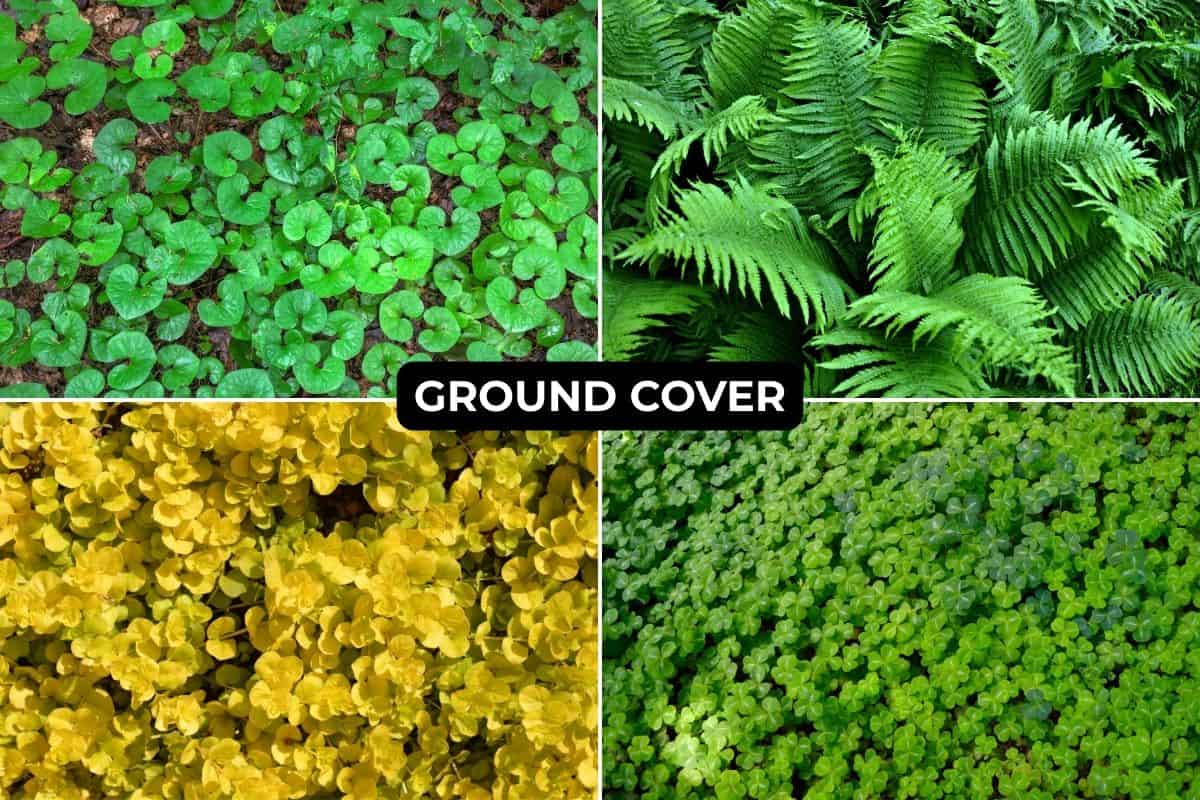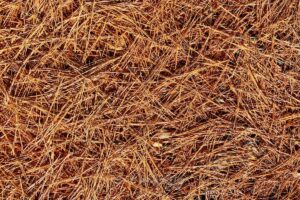This page may contain affiliate links. If you click and buy, we might get a small commission at no cost to you.
If you are looking for the best ground cover plants that thrive in shade, you have come to the right place. Below, we’ll highlight several great options that can handle low-light conditions, add beauty to your yard, and in many cases help with erosion or weed control. Let’s get right into the list!
1. Clover
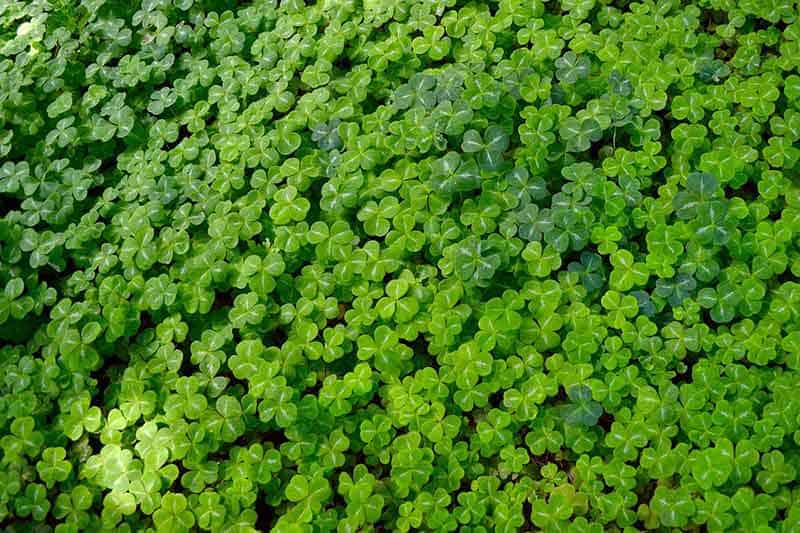
Species: Trifolium repens
Clover, particularly microclover and white clover, has become a popular grass alternative for partially shaded areas. It grows low to the ground, forms a dense mat, and naturally enriches the soil by fixing nitrogen. Clover produces small, white to pink flowers during the spring and summer months, which are highly attractive to pollinators like bees and butterflies. It’s a hardy choice that tolerates light foot traffic and occasional drought once established.
While clover prefers partial sun, it can handle light shade, making it a viable option for areas under trees or along shaded parts of a yard. Most varieties grow around 4-6 inches tall and spread quickly by creeping stems. It doesn’t require frequent mowing, can stay green even during dry spells, and helps crowd out weeds naturally without the need for chemical herbicides.
2. Creeping Jenny
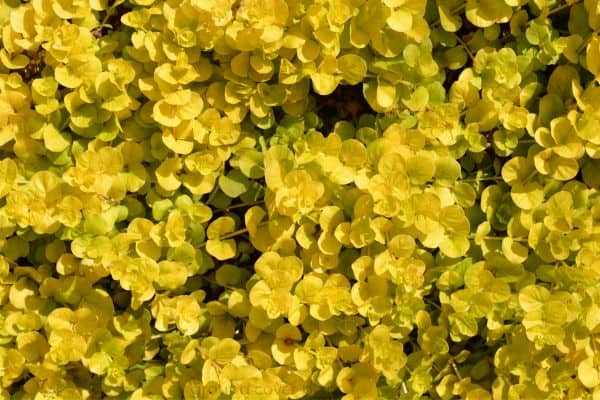
Species: Lysimachia nummularia
Creeping Jenny is a low-growing perennial known for its bright green or golden foliage and spreading habit. It thrives in shady spots where many other ground covers struggle, making it a great choice for under trees, along shaded borders, or beside patios. In spring and early summer, it produces small, cup-shaped yellow flowers that add a cheerful touch to the greenery.
This plant grows only about 2-4 inches tall but can spread rapidly across the ground, rooting at nodes along the stems. Creeping Jenny prefers moist, well-drained soil and can tolerate occasional wet conditions, but it may need trimming to prevent it from overtaking surrounding plants. It’s especially popular for adding color to shady areas without much maintenance.
3. Vinca minor
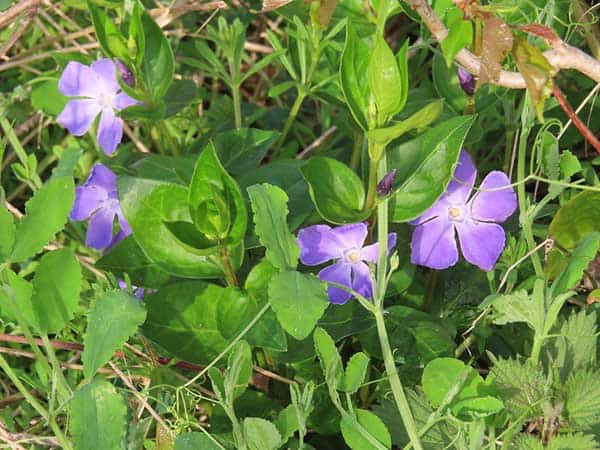
Species: Vinca minor
Also known as periwinkle or creeping myrtle, Vinca minor is a classic shade-tolerant ground cover that forms a dense mat of glossy green leaves. In the spring, it bursts into bloom with small, violet-blue flowers that continue sporadically through the summer. It’s highly valued for its ability to suppress weeds, stabilize soil, and add year-round greenery to shady spots.
Vinca minor typically grows about 4-6 inches tall and spreads quickly via trailing stems. It adapts well to a variety of soil types, including poor or rocky soils, and requires very little care once established. However, in some regions, it can become invasive if not managed, so it’s important to monitor its spread where necessary.
4. Sweet woodruff
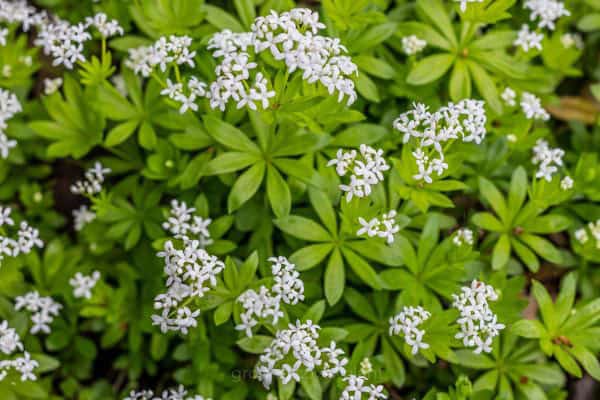
Species: Galium odoratum
Sweet woodruff is a fragrant, shade-loving ground cover often found in woodland gardens. It features whorled leaves and delicate, star-shaped white flowers that bloom in late spring to early summer. The plant is also known for its sweet hay-like scent, especially when the leaves are dried, and was historically used in perfumes and sachets.
Growing about 6-12 inches tall, sweet woodruff forms a soft, lush carpet under trees and along shaded borders. It prefers moist, rich soil but can adapt to drier conditions once established. Because of its pleasant aroma, attractive foliage, and low maintenance needs, it’s a favorite choice for shaded gardens that need a little extra charm.
5. Ajuga
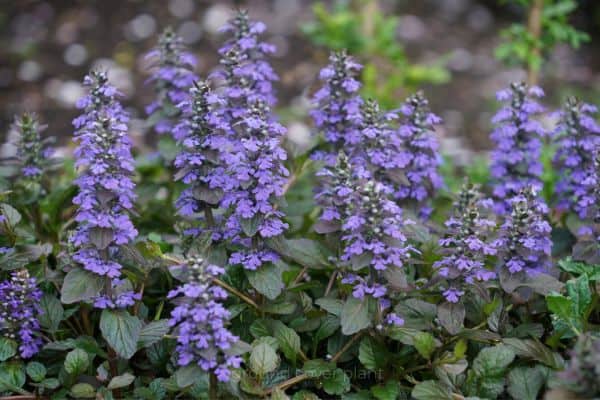
Genus: Ajuga
Ajuga, also called bugleweed, is a versatile ground cover known for its colorful foliage and low-growing habit. It thrives in shade or partial shade and produces dense spikes of blue, purple, or pink flowers in the spring. The foliage comes in a range of colors, from deep green to bronze or burgundy, depending on the variety, adding visual interest even when not in bloom.
Typically growing about 4-6 inches tall, Ajuga spreads through runners and can quickly cover bare soil, helping prevent erosion and suppressing weeds. It’s a hardy option for shaded areas where grass struggles, but it can become aggressive if not contained, especially in ideal growing conditions.
6. Moss
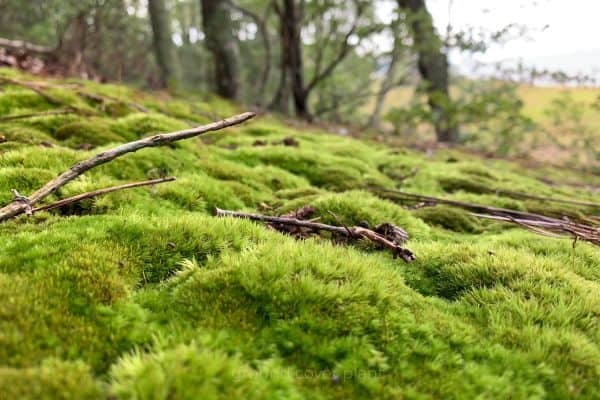
Group: Mosses (e.g., Hypnum, Dicranum, Thuidium)
Moss is a go-to ground cover for deep shade and consistently moist environments. It grows well in areas where grass completely fails, such as compacted soil, dense tree cover, or soggy woodland spots. Moss doesn’t produce flowers, but its rich green carpet creates a serene, natural look that works well in shaded gardens or along pathways.
Unlike traditional plants, mosses reproduce via spores and don’t have true roots. Most moss varieties stay under 2 inches tall and spread slowly but steadily over time, especially when undisturbed. They require minimal care beyond moisture and are excellent for low-traffic, shady areas where other plants struggle to survive.
7. Wild ginger
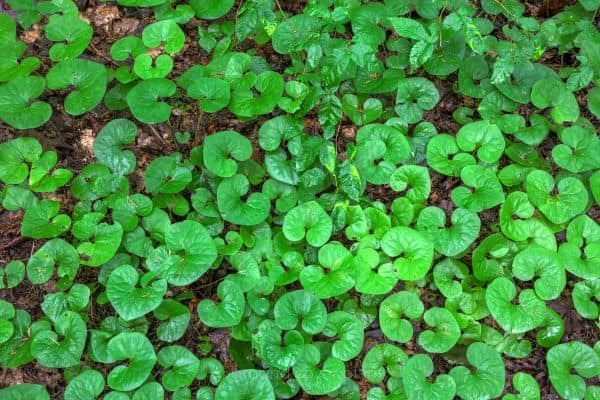
Genus: Asarum
Wild ginger is a shade-loving native plant that forms dense mats of heart-shaped leaves. It’s valued for its glossy foliage and low height, which make it perfect for naturalized ground cover under trees or in woodland gardens. In spring, it produces small reddish-brown flowers that are often hidden beneath the leaves and pollinated by ground-dwelling insects.
This plant typically grows 6 to 8 inches tall and spreads through rhizomes. Wild ginger prefers rich, well-draining soil and moderate moisture but can handle dry shade once established. It is not related to culinary ginger, but the roots have a mild scent that resembles it. Its dense growth helps suppress weeds and gives shady spots a lush, finished look.
8. Pachysandra
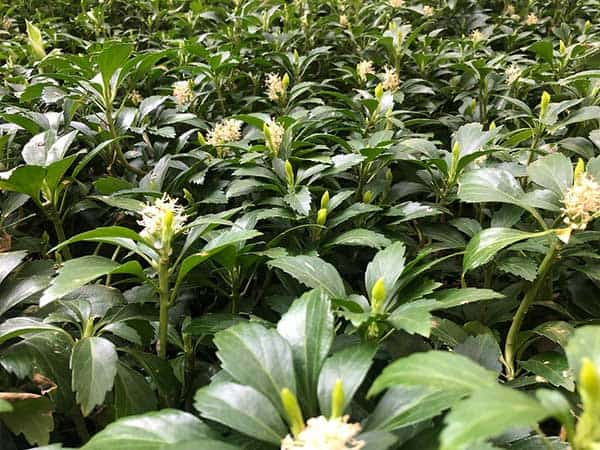
Genus: Pachysandra
Pachysandra is one of the most widely used evergreen ground covers for shade. It has glossy green leaves and small white flowers that bloom in early spring, although the foliage is the main attraction. Pachysandra spreads slowly but steadily, forming a thick carpet that suppresses weeds and keeps its color year-round.
This plant usually grows 6 to 10 inches tall and prefers moist, acidic soil with good drainage. It thrives under trees or in areas where grass won’t grow and requires little care once established. Some species, like Japanese pachysandra (Pachysandra terminalis), are more aggressive and may spread quickly in ideal conditions, so placement and containment are worth considering.
9. Canadian anemone
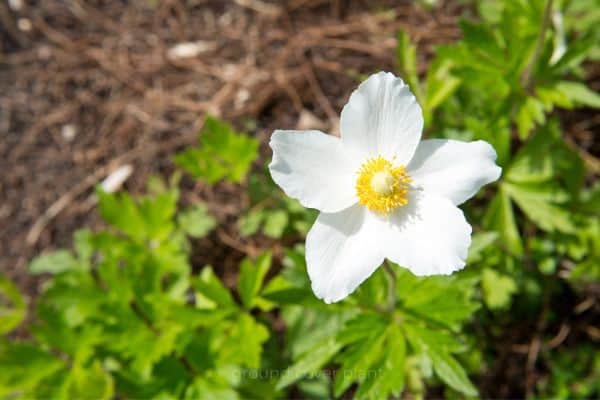
Species: Anemone canadensis
Canadian anemone is a native wildflower that works well as a ground cover in shady or partially shaded areas. It produces attractive white, buttercup-like flowers in late spring and early summer, adding a pop of brightness to darker garden spaces. Its upright leaves form a dense mass that helps control weeds and erosion.
This plant grows 12 to 18 inches tall and spreads aggressively via rhizomes, making it best suited for larger spaces or areas where you need quick coverage. It prefers moist soil and is often found near woodland edges or along shaded garden borders. With its showy flowers and fast growth, it can quickly turn a bare shady spot into a lush, flowering ground layer.
10. Lamium

Genus: Lamium
Lamium, commonly known as deadnettle, is a shade-loving ground cover prized for both its foliage and its flowers. The leaves often feature striking silver patterns or variegation, while the small tubular flowers bloom in shades of pink, purple, or white from spring through early summer. It brightens up dark corners of the garden and works well in mixed borders or under shrubs.
Lamium typically grows 6 to 8 inches tall and spreads moderately fast by trailing stems. It tolerates dry shade once established and can thrive in less-than-ideal soils. Many varieties remain semi-evergreen in mild winters, keeping some color and structure in shaded areas year-round. It’s an excellent choice for gardeners looking to add both function and beauty to their shady spaces.
11. Ferns
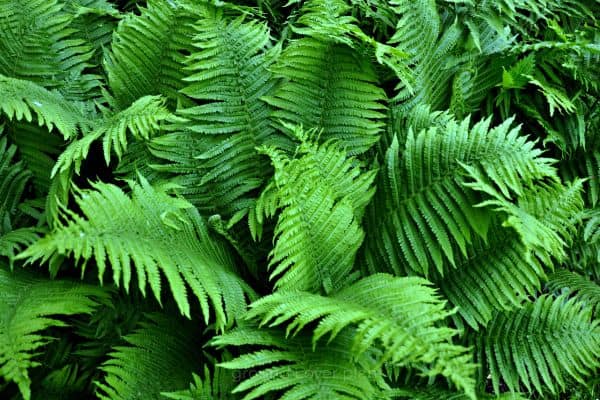
Group: Ferns (e.g., Matteuccia struthiopteris, Athyrium filix-femina)
Ferns are classic ground cover plants for shady gardens, especially in moist, wooded areas. Species like the ostrich fern and lady fern grow in clumps but can be spaced closely to create a dense, layered look. Their feathery fronds add a soft, textured backdrop and help create a natural, forest-floor aesthetic.
Ferns vary in size but many remain in the 18 to 36 inch range. They prefer moist, well-draining soil rich in organic matter. While not ideal for heavy foot traffic or dry areas, ferns are perfect for filling out large shady zones, especially when combined with other low-growing shade plants.
12. Hosta
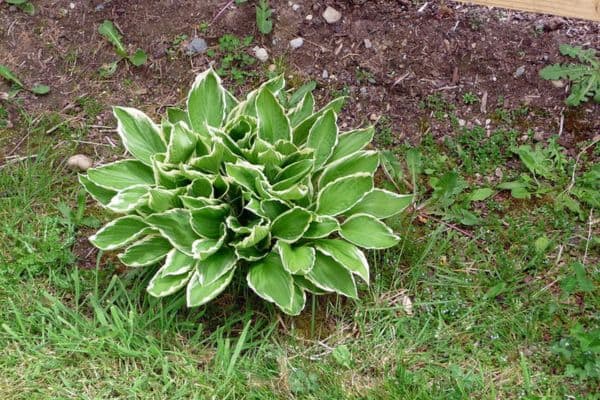
Genus: Hosta
Hostas are well-known perennials used as ground cover in mass plantings or large borders. They are shade-tolerant and come in countless varieties with different leaf shapes, colors, and sizes. Though not typically thought of as a ground cover, they can serve that purpose when planted densely in low-traffic areas.
Most hostas grow 12 to 24 inches tall, though some dwarf types stay under 10 inches. In midsummer, they produce tall spikes of lavender or white flowers that attract pollinators. Hostas prefer rich, moist soil and are generally low-maintenance, though they can be vulnerable to slug damage in very wet conditions.
13. Barrenwort
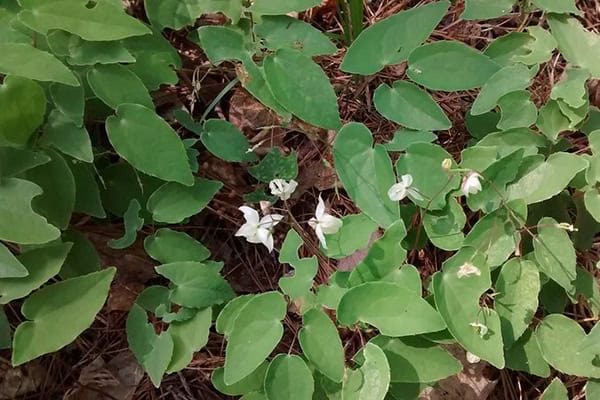
Genus: Epimedium
Barrenwort is a slow-growing but durable ground cover ideal for dry shade, particularly under large trees where little else survives. It has heart-shaped leaves that turn reddish in fall and delicate, spider-like flowers in spring that range from white to deep purple depending on the variety.
This plant typically grows 8 to 12 inches tall and spreads by rhizomes, although at a more manageable pace than aggressive ground covers. It’s more drought-tolerant than other shade plants and once established, needs little care. Its subtle beauty and tough nature make it a favorite among low-maintenance gardeners.
14. Foamflower
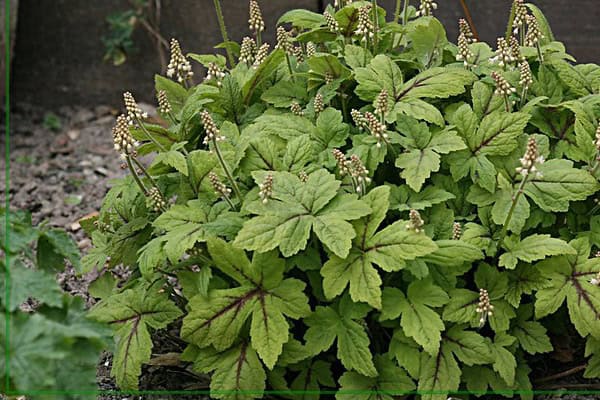
Genus: Tiarella
Foamflower is a native woodland perennial that serves as an excellent shade ground cover, especially in naturalized or woodland gardens. It features low-growing, lobed foliage and sends up spikes of tiny white or pink flowers in late spring that resemble frothy foam, giving the plant its name.
Foamflower generally grows 6 to 12 inches tall and spreads slowly via runners. It prefers moist, well-drained soil rich in organic matter and does well in dappled shade. As a native plant, it’s also beneficial to local wildlife and pollinators, making it an eco-friendly choice for shaded spaces.
15. Bugbane

Genus: Actaea (formerly Cimicifuga)
Bugbane is a taller ground cover option that works well at the back of shady borders or in large shaded beds. Known for its striking bottlebrush-style flowers and dramatic foliage, it adds vertical interest and texture where most ground covers stay low and flat. Flowers are usually white and bloom in mid to late summer.
Plants can grow 3 to 6 feet tall, so they are best used in layered plantings alongside lower shade covers. Bugbane prefers rich, moist soil and consistent moisture but can tolerate occasional dryness once established. Its foliage remains attractive through the growing season and can help anchor larger shaded planting areas.
